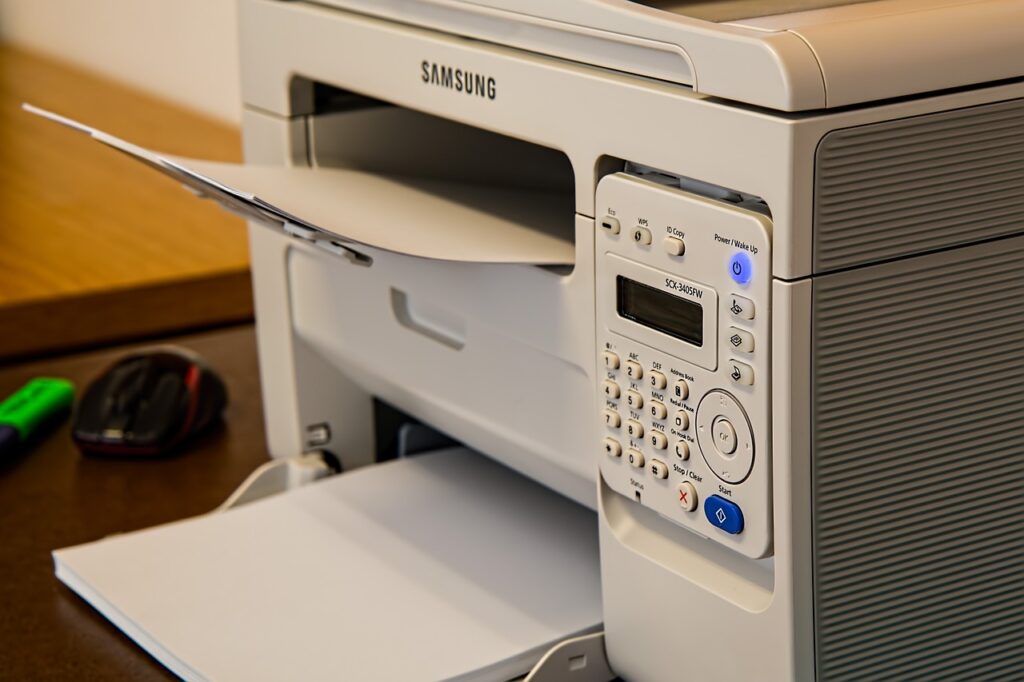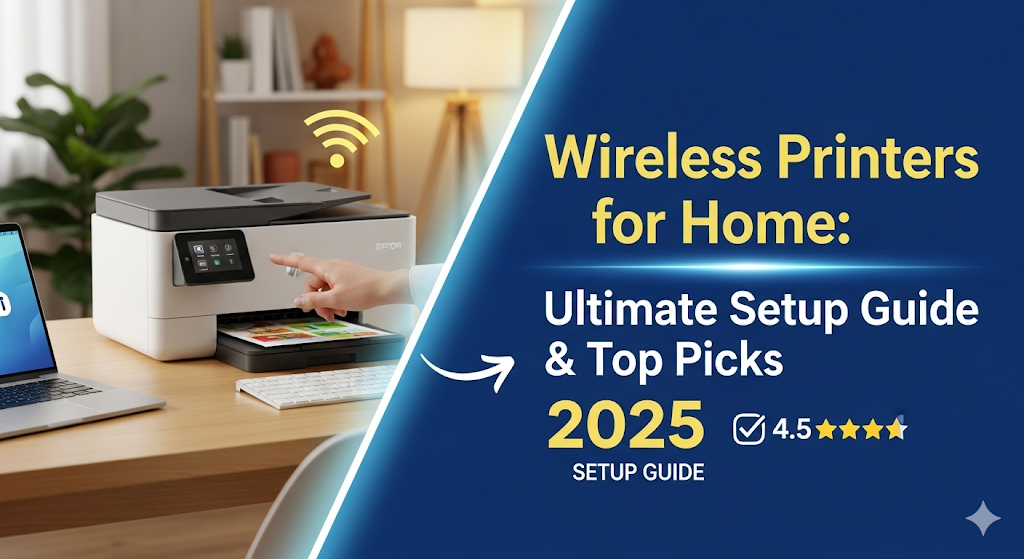Introduction
Choosing the right wireless printers for home can transform your printing experience from frustrating to effortless. Modern wireless printers eliminate the need for tangled cables and allow you to print from anywhere in your house. Whether you’re working from home, helping kids with school projects, or printing important documents, a reliable wireless printer is essential.
This comprehensive guide covers everything you need to know about selecting, setting up, and maintaining wireless printers for home use. You’ll discover expert tips, common troubleshooting solutions, and our top recommendations to help you make an informed decision.
What Are Wireless Printers for Home?
Wireless printers for home are printing devices that connect to your home network without physical cables. They use Wi-Fi technology to communicate with computers, smartphones, and tablets throughout your house.
These printers offer incredible convenience compared to traditional wired models. You can place them anywhere within your Wi-Fi range, not just next to your computer. Most modern wireless printers support multiple connection methods including Wi-Fi Direct, Bluetooth, and cloud printing services.
The technology has evolved significantly in recent years. Today’s wireless printers for home feature faster printing speeds, better print quality, and enhanced security features. Many models include touchscreen displays, automatic document feeders, and mobile app integration.
Popular brands like HP, Canon, Epson, and Brother offer various wireless printer models designed specifically for home use. These range from basic inkjet printers to advanced all-in-one models with scanning, copying, and fax capabilities.
7 Essential Steps to Set Up Wireless Printers for Home

Step 1: Choose the Right Location
Place your wireless printer in a central location with strong Wi-Fi signal strength. Avoid areas near microwaves, baby monitors, or other devices that might cause interference. Ensure adequate ventilation and easy access for paper refills and maintenance.
The ideal spot is within 30 feet of your wireless router with minimal obstacles like walls or furniture between them. Consider proximity to power outlets and whether you’ll need ethernet backup connectivity.
Step 2: Unbox and Prepare Your Printer
Remove all packaging materials and protective tape from your new wireless printer. Install the ink cartridges or toner according to the manufacturer’s instructions. Load paper into the appropriate tray and adjust the paper guides.
Most printers require an initial calibration process. This usually involves printing a test page to align the print heads and ensure optimal print quality.

Step 3: Connect to Your Wi-Fi Network
Access your printer’s control panel or touchscreen display. Navigate to the wireless setup menu and select your home Wi-Fi network from the available options. Enter your network password when prompted.
Some printers offer WPS (Wi-Fi Protected Setup) for easier connection. Simply press the WPS button on your router, then press the corresponding button on your printer within two minutes.
Step 4: Install Printer Software and Drivers
Download the latest printer drivers from the manufacturer’s official website. This ensures compatibility and access to all features. Install the software on each device you plan to use for printing.
Modern operating systems often include generic drivers, but manufacturer-specific software provides better functionality and troubleshooting tools.
Step 5: Configure Mobile Printing
Download the manufacturer’s mobile app on your smartphone or tablet. Popular options include HP Smart, Canon PRINT, and Epson iPrint. These apps allow you to print photos, documents, and web pages directly from your mobile devices.
Set up cloud printing services like Google Cloud Print or Apple AirPrint for seamless printing from various applications and devices.
Step 6: Test Print Quality and Settings
Print test pages from different devices to ensure everything works correctly. Check print quality, color accuracy, and alignment. Adjust settings as needed through the printer software or control panel.
Test various paper types and print modes to understand your printer’s capabilities and optimize settings for different tasks.
Step 7: Set Up Security and User Preferences
Configure password protection if your printer supports it. This prevents unauthorized access to your printer from outside your network. Set up user preferences like default paper size, print quality, and duplex printing options.
Consider setting print quotas or restrictions if multiple family members will use the printer, especially for color printing to manage ink costs.

Additional Tools and Features for Enhanced Home Printing
Modern wireless printers for home offer advanced features that enhance productivity and convenience. Automatic duplex printing saves paper and money by printing on both sides automatically. Some models include large paper trays that hold 500+ sheets, reducing frequent refills.
Scanner integration allows you to digitize documents and photos directly to cloud storage services. Advanced models offer OCR (Optical Character Recognition) to convert scanned documents into editable text files.
Mobile printing apps provide additional functionality like document editing, photo enhancement, and direct social media sharing. Some printers support voice commands through Amazon Alexa or Google Assistant for hands-free operation.
Consider investing in high-yield ink cartridges for better cost-per-page value. Third-party ink options can significantly reduce printing costs, though they may void your warranty.
Common Troubleshooting Issues and Solutions
Connection Problems: If your wireless printer won’t connect, restart both the printer and router. Check that you’re entering the correct Wi-Fi password and that your network supports the printer’s frequency band (2.4GHz vs 5GHz).
Poor Print Quality: Clean the print heads using your printer’s maintenance menu. Replace low or empty ink cartridges and ensure you’re using the correct paper type settings. Check for clogs in the ink nozzles and run alignment procedures.
Slow Printing Speeds: Reduce print quality settings for draft documents. Close unnecessary applications on your computer that might be consuming bandwidth. Consider upgrading your internet connection if you frequently print large files.
Paper Jams: Always remove paper carefully in the direction of the paper path. Check for torn pieces left inside the printer. Ensure paper is loaded correctly and not overfilled in the tray.
Mobile Printing Issues: Update your printer’s mobile app and ensure your device is connected to the same Wi-Fi network as the printer. Restart the app and check for firmware updates on your printer.
For persistent issues, consult your printer’s manual or contact manufacturer support. Many brands offer live chat support and comprehensive online troubleshooting guides.
Frequently Asked Questions
Q: How much should I spend on wireless printers for home use? A: Budget-friendly models start around $50-100 for basic printing needs. All-in-one models with scanning and copying typically range from $100-300. Consider long-term ink costs when making your decision.
Q: Can I print from my smartphone without installing apps? A: Yes, most modern smartphones support built-in printing protocols like AirPrint (iOS) and Mopria (Android). However, manufacturer apps often provide additional features and better compatibility.
Q: How often should I replace ink cartridges? A: This depends on your printing volume and cartridge capacity. Monitor ink levels through your printer software and replace cartridges when print quality declines or you receive low-ink warnings.
Q: Are wireless printers secure for home networks? A: Modern wireless printers include security features like WPA3 encryption and secure printing options. Always update firmware regularly and use strong Wi-Fi passwords to maintain security.
Conclusion
Wireless printers for home offer unmatched convenience and flexibility for modern households. By following proper setup procedures and understanding key features, you can enjoy seamless printing from multiple devices throughout your home.
Remember to consider your specific needs including print volume, quality requirements, and budget when selecting a wireless printer. Regular maintenance and firmware updates will ensure optimal performance and longevity.
The investment in quality wireless printers for home pays dividends in productivity and convenience. With the right model and proper setup, you’ll wonder how you ever managed without wireless printing capabilities in your daily life.
Perfect Printer for Home: Ultimate Family Selection Guide 2025 Read More.




